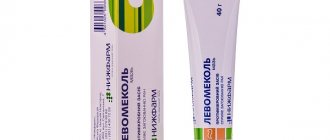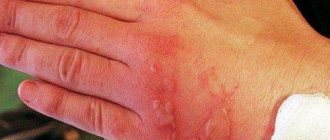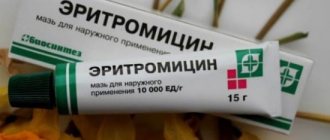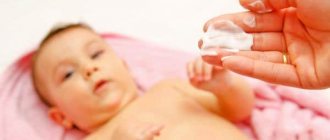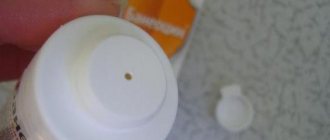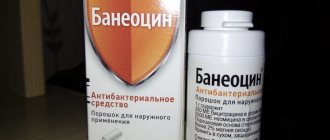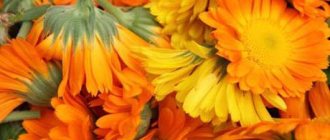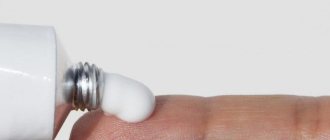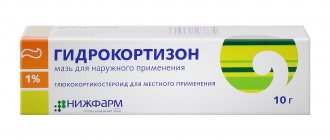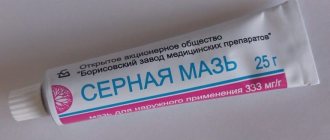Baneocin doctor reviews
Local antibiotic
A good local antibacterial agent. The composition contains two antibiotics, which potentiate (strengthen) the effect of each other.
The drug is used for local treatment and is practically not absorbed through intact skin, therefore, systemic effects are excluded as much as possible. But, if the drug is applied to a large affected area or is used in small children, then side effects from using Baneocin are possible.
When using the drug, you should avoid exposure to the sun or hide the areas treated with the drug from the sun, as the likelihood of sunburn increases significantly.
During pregnancy, Baneocin is not recommended for use, as there is evidence of the possibility of damage to the hearing organs of the fetus.
When breastfeeding, with minor skin lesions, you can use Baneocin. If the drug is used directly on the mammary gland, then before feeding it is necessary to carefully remove any remaining substance using boiled water and cotton wool.
In pediatrics, the use of this product is possible, but only as prescribed by a doctor.
In general, the drug is very good, I use it in my practice.
Effective drug
Antibacterial drug of combined action. Contains 2 antibiotics, which, when acted together, enhance each other.
It is used for wounds, bruises, abrasions, injuries, after surgical interventions, purulent wounds, carbunculosis and boils. The range of applications is very wide.
The drug is very effective. Mainly prescribed in powder form, it is easy to use for both adults and children. The drug is safe for children; no allergic reactions or side effects have been observed in practice.
This drug should be in everyone's first aid kit.
Baneocin - ease of use and high efficiency
In the practice of a pediatrician, Baneocin is used only in powder form. Therefore, my review is specifically about the powder form of Baneocin.
Injuries, cuts, abrasions and burns always haunt children. There is no escape from this. But it is possible and necessary to prevent the development of purulent complications in wounds. To do this, I always recommend that parents keep Baneocin with them.
I also prescribe powder to prevent suppuration of opened herpetic and chickenpox rash elements (for treating ulcers and skin erosions). In order to prevent infection of the umbilical wound, Baneocin powder always comes to the rescue. When the umbilical wound becomes wet for a long time, it dries it out and prevents pathogens from growing, thereby saving babies from inflammation of the umbilical vessels with subsequent complications. If diaper dermatitis occurs, this remedy has also proven itself to be the best. Separately, it is worth noting the fact that Baneocin is as effective as it is safe. These properties have been proven by many clinical studies in the field of dermatology.
Considering that Baneocin is a complex remedy with proven effectiveness and a high safety profile, I prescribe this drug without any particular doubts. In addition, no side effects or other adverse effects were observed when used personally and in my clinical practice.
Baneocin - ointment for topical use
Baneocin is a local drug that contains 2 broad-spectrum antibiotics: bacitracin and neomycin sulfate. Their combination in one preparation provides double protection against bacteria and a huge antimicrobial effect.
Both gram-negative and gram-positive bacteria. Therefore, its use is quite often used in surgical practice. For the treatment of inflammatory processes after operations, suppuration of an open wound, boils, carbuncles, infections after burns.
Since when applied locally, the ointment is practically not absorbed into the systemic bloodstream, this largely reduces the risk of antibiotics affecting the entire body. Action - Baneocin occurs only locally, which has a number of advantages. Since the risks of impact on the hearing organs, abdominal organs, and intestines are reduced. This makes it easier to use and expands the range of its applications.
The drug exists in 2 forms of release in the form of ointment or powder, which is very convenient for use. The powder can also be used for children from birth, which proves its safety in use and high efficiency. Its powder form has a cooling and anti-inflammatory effect, allowing a high percentage of its use to be non-contact, especially in burn patients.
So, we encounter infectious processes quite often, which causes high resistance of microorganisms to the action of antibiotics. Therefore, the use of the complex drug Baneocin takes place in the practice of doctors in various fields. Since it has a high efficiency and therapeutic effect in the affected area. And it has affordable quality.
A yellowish drug intended for external use and having a weak characteristic odor is Baneocin ointment. It has an antibacterial effect and can be used for adults and children. This medicine, which is packaged in aluminum tubes of 20 g, can be freely purchased at the pharmacy.
Doctors' reviews about the drug
As mentioned above, doctors speak only positively about Baneocin powder and ointment. In their opinion, this is one of the few drugs that can cope with absolutely any disease, including an infectious one.
According to medical practice, the use of this product in recommended dosages allows you to get rid of bruises, boils, lichen, dermatitis and other undesirable conditions in the shortest possible time.
Many doctors are also pleased by the fact that the drug “Baneocin” is completely safe for small children, including newborns.
pharmachologic effect
The drug contains two antibiotics ( neomycin and bacitracin
), which have a bactericidal effect and enhance each other’s effects (synergistic effect).
Neomycin has an antimicrobial effect and is active against both gram-negative and gram-positive microorganisms.
The action of bacitracin is directed against gram-positive microorganisms , which include clostridia, staphylococci, the causative agent of diphtheria, hemolytic streptococcus, treponema pallidum
, as well as some types of gram-negative microorganisms.
The instructions indicate that the use of Baneocin ointment is ineffective against pseudomonads, most fungi, and viruses.
The drug has good tissue tolerance and is available in two forms - ointment and powder. Many patients have a question: which is better Baneocin powder or ointment? You should be aware that when applying the powder, natural sweating occurs, as a result of which the treated area is subjected to a cooling effect. The choice is yours and your doctor's.
For all occasions: ointment for force majeure
Baneocin is a fatty, slightly yellowish ointment with a neutral odor. It is packaged in aluminum tubes of 20 grams. It is produced by a well-known Austrian pharmaceutical company. It contains two effective antibiotics that enhance their mutual effect. The first one is batracin. It eliminates gram-positive bacteria. The second is neomycin. It is more powerful because it also destroys gram-negative microorganisms. To give the ointment a creamy consistency, fillers were also added to it - lanolin and soft paraffin. The product is used exclusively externally, has high tissue permeability, is indicated for bacterial infections, accelerates healing, promotes the resorption of hematomas, and prevents the risk of infection. The ointment does not lose its therapeutic properties upon contact with skin, blood or pus.
Indications for use
What does Baneocin ointment help with? She copes well with many skin diseases. Let's consider in which areas of medicine the use of Baneocin is effective.
Pediatrics
The use of Baneocin ointment for children, and especially infants, is carried out strictly as prescribed by the doctor . Treating the skin of babies with the drug is justified in the following cases:
- diaper dermatitis, which is accompanied by bacterial complications;
- treatment of the umbilical wound in newborns;
- care for chickenpox rashes.
Dermatology
The use of the product in dermatology has become widespread for the following skin diseases:
- weeping contagious impetigo;
- with boils;
- carbunculosis;
- folliculitis;
- hidradenitis;
- pyoderma;
- eczema and trophic ulcers accompanied by infection;
- with herpes, which occurs with complications;
- infectious dermatitis;
- herpes zoster, occurring with bacterial complications;
- skin ulcers with purulent discharge;
- with streptoderma.
Surgery
Surgeons recommend using Baneocin ointment for wounds under the following circumstances:
- care of wound surfaces, as well as sutures after surgical operations;
- in order to prevent infectious complications from burns.
Gynecology
Women are prescribed the use of ointment mainly after childbirth and during breastfeeding in the following situations:
- care for wounds, cracks and sutures of the perineum formed during labor, as well as after episiotomy;
- for treating nipples that have cracked while feeding the baby.
Otolaryngology
The ears and nose are also often affected by infection. Baneocin ointment will become indispensable under the following circumstances:
- infection of the ear and nose cavities;
- otitis externa;
- secondary infections with rhinitis;
- as a preventive measure for the development of secondary infection after surgery on the nasal sinuses.
Important! Before using the drug, you should consult a specialist, because Baneocin is a combined antibiotic. If there are contraindications for use, unpleasant consequences may occur.
Use in pediatrics
Reviews from pediatricians about Baneocin are positive. Doctors say that this drug is completely safe for children. The medicine in powder form can be used to treat the umbilical wound from the first day of the baby’s life.
According to expert reviews, the effectiveness of this product is very high. The umbilical wound heals within 2-5 days.
The powder is also actively used for treating native wounds and treating a festering or weeping umbilical stump.
How should Baneocin be used for streptoderma in children? Reviews from experts say that to treat such a disease, the affected area of the skin is sprinkled with powder twice a day.
This form of the drug should be kept in your first aid kit, especially if you have small children.
According to pediatricians, this remedy is excellent for healing scratches, wounds, bites, cuts, calluses, as well as skinned elbows and knees. If the baby is burned, the damaged area of skin should also be sprinkled with powder. This will significantly speed up his recovery.
Doctors say that Baneocin powder successfully replaces brilliant green, iodine and alcohol.
Infants often develop diaper dermatitis and prickly heat. These diseases are also perfectly treated with the medication in question. In this case, the powder is used as regular baby powder. As a rule, complete epithelization of scars occurs after 6-10 days.
Contraindications
All medications have their own prohibitions on use. Let's consider what contraindications Baneocin ointment has for children and adults.
- Severe malfunction of the excretory organs, accompanied by the development of renal or heart failure.
- Very large area of skin damage. If you use the ointment in this case, an ototoxic effect may develop, resulting in hearing loss.
- Disturbances in the functioning of the vestibular system.
- Individual immunity to the components that make up the ointment.
Action
The drug Baneocin enters the bloodstream through the skin and is excreted by the kidneys. If the ointment is used frequently and the treated skin areas are large, the drug may accumulate in the body. When used correctly (according to the instructions), the absorption of the product is minimal.
When the ointment hits the skin, it immediately begins an intensive fight against bacteria . The inflammatory process passes much faster, and due to the drying effect, acne disappears quite quickly. The use of Baneocin ointment for acne gives excellent results.
Pharmacokinetic parameters
Is Baneocin absorbed into the systemic circulation? Reviews from doctors say that the active components of this product are not absorbed even if there is damage to the skin. However, after using this drug, fairly high concentrations of the drug may be present in the skin.
The drug "Baneocin" has good tissue permeability. When applying the medicine to large areas of the body, the likelihood of systemic absorption of antibiotics must be taken into account.
Inactivation by tissue components, blood and biological products is not observed in the drug.
How to use
Using the ointment is simple, however, to obtain the expected result, you should strictly follow the instructions for use:
- Apply the ointment in a thin layer to cleansed skin . It is not advisable to use soap in this case, since in combination with an antiseptic drug the skin can become very dry. It is better to wipe the skin with alcohol-free lotion, then pat dry with a clean towel or napkin.
- Adults should use the ointment 2-3 times a day, children - 1-2 times . If necessary, the drug can be applied under a gauze bandage. This will only increase the effectiveness of the drug.
- The daily dose of ointment used should not exceed 1 gram , and the course of treatment is from 7 to 10 days. When prescribing a repeated course, the maximum permissible dose is reduced by 2 times.
- If the product is used for burns, and the affected skin surface occupies more than 20% of the patient’s body area, then the drug is used only once a day.
- When using an ointment to prevent mastitis, before feeding, a woman should carefully remove any remaining medication using sterile cotton wool or a bandage and boiled water.
- If it is necessary to introduce the ointment into the cavity of the ear, nose or wound surface, then the drug should be applied in a thin layer to a turunda made of bandage or cotton wool, and then injected into the affected cavity. Turundas are changed every 8-12 hours, and the duration of the course of treatment is determined by the attending physician.
- Good results are obtained by using Baneocin ointment for the treatment of acne and pustular rashes in the facial area. In this case, the product is applied either pointwise (for a small amount of pimples) or in a thin layer (for heavy breakouts). It is enough to carry out the procedure once, at night. Usually, after 2-3 days, noticeable positive changes in the condition of the skin occur.
Advice! Before using Baneocin ointment, the microflora that caused the disease should be checked for sensitivity to the drug.
Doctors' recommendations for using the drug
Before using Baneocin powder or ointment, you should definitely consult your doctor. According to them, this drug must be applied locally to adults and children, that is, strictly to the infected area. If necessary, the medicine can be covered with a gauze bandage.
Treat the affected areas with ointment or powder 2-4 times a day. If burns are being treated, damage from which covers more than 15% of the entire body, then treatment with drugs is carried out once a day. This limitation is due to the likely absorption of the drug into the systemic circulation.
The maximum permissible dose of the drug is 1 g of active substance per day. This corresponds to 200 g of ointment or powder.
Treating a patient in excess of the specified dosages can lead to the absorption of large amounts of antibiotics into the blood, which can lead to toxic damage to the kidneys and ear. Therefore, during therapy with Baneocin, the patient’s condition should be regularly monitored by doing urine and blood tests, as well as a hearing test.
When treating large incisions and wounds, as well as infections of the ear canal (for example, otitis externa), the medicated ointment should be applied to the turundas, which subsequently need to be inserted into the ear cavity or wound.
When using the drug, you must ensure that it does not get into your eyes.
Long-term use of powder or ointment can lead to the development of fungal infections, which will require the prescription of additional drugs.
If, while using Baneocin, the patient develops an allergy or has any other infection, the drug must be discontinued.
Side effects
Let's consider what side effects the use of the drug Baneocin can cause.
- Allergic reactions . If the ointment is used for a long time, redness, dryness of the skin, rash, and itching are possible. Allergic reactions occur as contact eczema and develop infrequently.
- If the area of skin affected by the disease is extensive, then the drug is absorbed in large quantities, which can provoke oto- and nephrotoxic effects and neuromuscular conduction disorders .
- If an allergy or superinfection develops, the drug must be discontinued.
When applied topically, the ointment usually does not cause any adverse reactions and is well tolerated by patients.
Baneocin ointment for external use, tube 5g No. 1 122206
Latin name
Baneocin®
Active substance
Bacitracin + Neomycin*(Bacitracinum + Neomycinum)
ATX:
D06AX Other antibacterial preparations for local use
Nosological classification (ICD-10)
L01 Impetigo L02 Skin abscess, boil and carbuncle L03.0 Phlegmon of the fingers and toes L08.0 Pyoderma L08.9 Local infection of the skin and subcutaneous tissue, unspecified L30.3 Infectious dermatitis L73.2 Purulent hidradenitis L73.8.0* Sycosis L73.8.1* Folliculitis L98.4 .1*
Compound
Ointment for external use 1 active substances: bacitracin (in the form of bacitracin zinc) 250 ME neomycin (in the form of neomycin sulfate) 5000 ME excipients: lanolin; soft paraffin white
pharmachologic effect
Pharmacological action: local antibacterial, broad-spectrum bactericidal.
Directions for use and doses
Externally. The ointment is applied in a thin layer to the affected areas 2-3 times a day for adults and children; if appropriate, under a bandage. The area where the ointment is applied should not exceed 1% of the body surface area (which corresponds to the size of the patient's palm). The dose of neomycin for adults and children under 18 years of age should not exceed 1 g/day (about 200 g of ointment) for 7 days. For patients with impaired liver/kidney function and the elderly, no dose adjustment is required.
Release form
Ointment for external use, 250 IU/g + 5000 IU/g. 5 g or 20 g of ointment for external use in aluminum tubes; 1 tube in a cardboard box.
Manufacturer
Merck KGaA und Co., Hesslgasse 20, A-9800, Spittal an der Drau, Austria. Holder of the registry: Sandoz d.d., Verovshkova 57, 1000 Ljubljana,
Conditions for dispensing from pharmacies
Over the counter.
Storage conditions
At temperatures below 25°C. Keep out of the reach of children.
Best before date
3 years. Do not use after the expiration date indicated on the package. 2000-2017. Register of Medicines of Russia
Indications
Baneocin® ointment is indicated for use in infections caused by microorganisms sensitive to neomycin and/or bacitracin. focal skin infections, such as boils, carbuncles (after surgical treatment), staphylococcal sycosis, deep folliculitis, hidradenitis suppurativa, paronychia; bacterial skin infections of limited prevalence , for example contagious impetigo, infected ulcers of the lower extremities, secondary infected eczema, secondary infection in dermatoses, cuts, abrasions, burns, in cosmetic surgery and skin grafting (also for prophylactic purposes and for impregnation of dressings); prevention and treatment of infection after surgical interventions — Baneocin® ointment can be used as an additional treatment in the postoperative period. Application of Baneocin® ointment to bandages is preferable for local treatment of patients with infected cavities and wounds (for example, bacterial infections of the external auditory canal without perforation of the eardrum, wounds or surgical incisions healing by secondary intention).
Contraindications
hypersensitivity to bacitracin and/or neomycin, aminoglycoside antibiotics, auxiliary components of the drug; extensive skin lesions, since absorption of the drug can cause an ototoxic effect accompanied by hearing loss; pronounced disturbances in excretory function due to heart or renal failure in patients with existing lesions of the vestibular and cochlear systems in cases where absorption of the active components of the drug is possible. simultaneous use with systemic aminoglycoside antibiotics (due to the risk of cumulative toxicity); infections of the external auditory canal with perforation of the eardrum; use for the treatment of eye infections. With caution: in patients with decreased liver and/or kidney function, acidosis, myasthenia gravis or other neuromuscular diseases.
Use during pregnancy and breastfeeding
The use of Baneocin® during pregnancy and breastfeeding is possible only after consultation with a doctor if the expected benefit to the mother outweighs the potential risk to the fetus and infant. It should be remembered that neomycin, like all aminoglycoside antibiotics, can penetrate the placental barrier. Prenatal hearing loss in the fetus has been described with the use of systemically high doses of aminoglycoside antibiotics.
Description of the dosage form
Ointment for external use: yellowish, homogeneous ointment with a weak characteristic odor.
Pharmacodynamics
Baneocin® is a combined antibacterial drug intended for topical use. Baneocin® contains two bactericidal antibiotics: neomycin and bacitracin. Bacitracin is a polypeptide antibiotic that inhibits bacterial cell wall synthesis. Neomycin is an aminoglycoside antibiotic that inhibits bacterial protein synthesis. Bacitracin is active against gram-positive microorganisms such as beta-hemolytic streptococci, staphylococci, and some gram-negative pathogens. Resistance to bacitracin is extremely rare. Neomycin is effective against gram-positive and gram-negative microorganisms. Using a combination of these two substances, a wide spectrum of action of the drug and synergistic action against a number of microorganisms, such as staphylococci, are achieved.
Pharmacokinetics
The active ingredients, as a rule, are not absorbed (even by damaged skin), however, their high concentrations are present in the skin. Baneocin® is well tolerated. Tissue tolerance is assessed as excellent; inactivation by biological products, blood and tissue components is not observed. If the drug is applied to large areas of skin lesions, the possibility of absorption of the drug and its consequences should be taken into account (see sections “Side effects”, “Interaction”, “Contraindications” and “Special instructions”).
Interaction
With systemic absorption of the active components, the simultaneous use of cephalosporins or aminoglycoside antibiotics may increase the likelihood of nephrotoxic reactions. Simultaneous use of diuretics such as ethacrynic acid or furosemide with Baneocin® ointment can provoke an oto- and nephrotoxic effect. The absorption of the active components of the drug Baneocin® may increase phenomena of blockade of neuromuscular conduction in patients receiving narcotic substances, anesthetics and/or muscle relaxants.
Overdose
When used in doses significantly higher than recommended, especially in the treatment of (neuro)trophic ulcers, nephro- and/or ototoxic reactions may occur due to possible absorption of active components.
special instructions
Since the risk of toxic effects increases with decreased liver and/or kidney function, in patients with liver and/or renal failure, blood and urine tests should be performed along with an audiometric study before and during therapy with Baneocin®. When the active components of Baneocin® are absorbed, attention should be paid to potential blockade of neuromuscular conduction, especially in patients with acidosis, myasthenia gravis or other neuromuscular diseases. However, calcium preparations or neostigmine methyl sulfate can prevent the development of such blockades. With long-term treatment, attention should be paid to the possible growth of resistant microorganisms. In such situations, you should choose the appropriate treatment tactics. In the case of using the drug in children, patients with impaired liver and kidney function, as well as with a large surface area to be treated, long-term use and deep skin lesions, it is recommended to first consult a doctor. For patients who have developed an allergy or superinfection, the drug should be discontinued. The development of photosensitivity or phototoxic reactions in patients using Baneocin® ointment is possible when exposed to the sun or exposure to UV radiation. Impact on the ability to drive vehicles and operate machinery. No special precautions required.
Pharmacological groups
Combined antibiotic [Aminoglycosides in combinations]Combined antibiotic [Other antibiotics in combinations]
A comment
RU1708679181
Side effects
Undesirable effects are given in accordance with the WHO classification according to the frequency of their development as follows: very often (≥1/10); often (from ≥1/100 to
Possible product names
- Baneocin ointment for external use, tube 5g No. 1
- BANEOTSIN OINTMENT 5.0
- (Baneocin) Baneocin ointment for external use, tube 5g No. 1
Baneocin during pregnancy
Antibiotics contained in Baneocin ointment are absorbed into the blood in small quantities, but through the bloodstream they can penetrate the placenta and harm the fetus. That is why the use of this drug during pregnancy, as well as during breastfeeding, should be extremely careful . Basically, the doctor decides to use Baneocin during such a crucial period of a woman’s life if the expected benefit is higher than the expected consequences.
Reviews
I had a difficult period when boils appeared one after another and brought a lot of unpleasant moments. I didn’t go to the hospital right away, I was still embarrassed, but when I finally went to the doctor, he prescribed Baneocin ointment. I was treated for 10 days, I’m happy with the result.
I suffered from acne, and finally found a good specialist who advised me to use Baneocin ointment. I also read reviews on the Internet and decided to try it. I didn’t even expect such a result; now my skin is clear.
And I developed complicated herpes. How much I suffered with him! Not only can you not go anywhere with such an appearance, but the pain is constant. I went to the doctor and recommended Baneocin ointment. I had the treatment and am very pleased with the result.
All information is provided for informational purposes. And it is not an instruction for self-treatment. If you feel unwell, consult a doctor.
Negative reviews
- does not sting wounds
- used sparingly
- absolutely inconvenient packaging
- does not help with weeping wounds
- price
A little adventure happened to me here, as a result of which I received quite deep abrasions on both knees. The wounds were quite large, they were bleeding, they were wet - in general, the whole package. I bought Baneocin powder at the pharmacy, used it for about a week, and under a bandage and keeping the wounds open, there was practically no effect. The wounds became wet, secreting ichor. On the advice of a friend, I changed this advertised product to streptocide - the wounds stopped getting wet literally in 1 day, and on the second day the epithelial process began.
On the plus side, it doesn’t sting. The packaging is inconvenient; it is difficult to regulate the amount and direction of the poured powder.
Attention!
Before using medications, consult a specialist!
- Dries out pimples well
- crusts form on the wound
- expensive drug
I used Baneocin powder to heal a baby’s weeping umbilical wound on the advice of a doctor from the maternity hospital. For these purposes, the drug did not help us, but rather aggravated the healing process. After use, crusts form on the navel, which then roll off and the navel begins to get wet again, so we again returned to brilliant green and hydrogen peroxide, began to treat the navel more often, dripped peroxide 3 times a day, then blotted it and treated it with brilliant green. Baneocin is good for lubricating pimples and small wounds, as it dries quickly. But why pay extra money if the cheaper streptocide is no worse!
Neutral reviews
Attention!
Before using medications, consult a specialist!
The other day, my daughter developed heat rash in the crease under her knee for the first time in six months. At first I applied Bepanten, but it didn’t help. Then I remembered that sea buckthorn oil was considered by our mothers to be a first aid remedy for all occasions. There was no effect. We went to a dermatologist (I still had a suspicion that it was not just heat rash, but a manifestation of an allergy; the doctor dispelled my doubts, confirming that it was a common heat rash)
I immediately started using Baneocin powder (to relieve inflammation) and salicylic-zinc paste, which dries out the skin. On the fourth day, the leg was almost healed. At the same time, I had to change the style of clothing for the child. We really love onesies. To ensure that the leg is well ventilated during the day, they began to wear a bodysuit.
I note that the preparation has a convenient packaging, thanks to which you can pour a small amount of powder onto your finger - as much as is needed for a small wound. Economical packaging.
It’s just a pity that “Baneotsin”, like many other ointments used for children, is expensive - from 200-300 rubles - because it is imported.
Attention!
Before using medications, consult a specialist!
- convenient to use, in powder form
My husband and I were going on vacation and on the way I accidentally broke my extended nail; it broke, taking my own nail too. There was terrible pain and bleeding. On the way we stopped at a pharmacy to buy something to treat the wound. The pharmacy recommended Baneocin powder, which supposedly has an antibacterial effect. I've heard about it before, but haven't used it. After washing the wound with water, she applied the powder. Baneocin was applied several times a day to the wound site for several days.
The powder itself is white. Packaged in an opaque small tube, the contents are poured out through a small hole. The total amount of powder is 10 g, which lasts a long time as it is used sparingly. The shelf life is also good, 3 years.
Later I took a closer look at the instructions and was disappointed. After all, it turns out that Baneocin is an antibiotic. Therefore, it should not be used by children, pregnant or lactating women, and in general should be used as rarely as possible.
Three years ago I bought a jar of Baneocin powder for 210 rubles, I think it’s a little expensive. After the expiration date expired I did not purchase any more.
My friend had a baby three months ago. They did not use diapers during the day, only at night and during walks. And after a while a terrible heat rash appeared in the area of the legs. They turned to the pediatrician, and she prescribed them this remedy. They used it with caution, since this ointment is an antibiotic and has contraindications and side effects. For the first two days she applied it twice a day and for the next two days once at night. I began to use powder more and wash it more often, about five times, and the baby went away for a day. The pediatrician said that this is a common occurrence, since the baby’s skin is very delicate and sensitive. This medicine is not expensive, but it should be used only after a doctor's prescription.
Hello everyone, friends. This time I want to share with you my opinion about the medicinal powder Baneocin. Those who have small children, I am sure, should have already become familiar with this medicinal product, since this powder is used for various types of infections. for example, some use it to heal the umbilical wound, when it does not heal for a long time, or when wounds appear.
Positive reviews
- antibacterial effect
- good wound healing
The nurse recommended the anti-diaper rash drug Baneocin to us. I am very grateful to her for this. Relieves inflammation, dries the baby's skin very well, and recovery occurs faster. The jar is small, but lasts a very long time. Costs approximately 9,000 - 10,000 Belarusian rubles. I highly recommend it to mothers whose babies are newborns and have not yet “learned” to sweat!
- antibacterial effect
- fast healing
- does not sting wounds
- used sparingly
- convenient packaging
- good wound healing
I have a little daughter, 4 years old, very lively and active. She rushes around the apartment like a hurricane and, naturally, collects all the corners along the way. Zelenka and iodine are not the most convenient way to treat wounds, and the child is not happy with them. That's why I recently purchased Baneocin. Baneocin powder is an excellent remedy for treating wounds and scratches. It dries wounds very well and promotes their speedy healing (I tried it on myself). It is very convenient to use, it is compact and economical. Now Baneotsin is my faithful friend and assistant, he is always with me both at home and at work.
We used baneocin powder on the advice of a visiting nurse from the clinic in the first month of our son’s life. After being discharged from the maternity hospital, the umbilical wound did not heal for a long time, it bled, the crusts dried out, the mother was very worried, they bathed the child in boiled water. The navel was treated as usual: with hydrogen peroxide and brilliant green; in between, baneocin powder was poured into the navel after treatment with hydrogen peroxide 2-3 times a day for about 7 days. Everything healed without side effects. Convenient packaging, the tube closes tightly. An inexpensive, effective remedy that I recommend to anyone who faces similar problems.
Attention!
Before using medications, consult a specialist!
My children, playing in the yard, riding a bike, running, jumping, fall very often, which leads to abrasions and serious wounds that have to be treated as soon as possible. We immediately treat the resulting injuries with essential medications in such cases - iodine and hydrogen peroxide. These remedies, of course, are good and effective, but sometimes they bring children to tears, hissing and pinching the affected area. But recently I learned about baneocin. This is an excellent antibacterial, powdered product made in Austria that is great for treating all types of injuries. It helps us a lot. The wound is quickly neutralized and healed. The only drawback of this drug is the price. For the smallest jar of ten grams you have to shell out about 250 rubles, but what can you do, you won’t save on your children’s health.
Attention!
Before using medications, consult a specialist!
- for those who have children it is simply necessary.
In 2015, I had a caesarean section, and the maternity hospital recommended this powder to me; there was not even any redness at the seam. The godson fell and scratched his face very badly; in a couple of days everything went away with the help of this powder. Now I recommend him to everyone.
The price in this case is justified
- Quickly heals diaper rash and injuries
- economical consumption.
I became acquainted with this powder, which is often advertised on TV, after the birth of my child. It is not clear why the baby developed diaper rash, so much so that it bled. Neither ointment, nor cream - nothing helped. I had to go to see a doctor. He prescribed Baneocin powder. There is also an ointment, but the first option is better for small children.
The price is high. I paid 400 rubles for a bottle containing only 10 grams of the drug.
Contains antibiotics (bacitracin, neomycin) plus various auxiliary components.
The product is white, similar to baby powder - odorless and slightly dusty when applied.
The dispenser is a small hole, and this creates some inconvenience. I pour the required amount onto a piece of paper and apply it to the sore spots with cotton wool.
But the effect was surprising - overnight the diaper rash healed and turned pale. And soon they disappeared.
I recommend that all mothers keep this medication in their medicine cabinet.
Excellent healing ointment
- has an anti-inflammatory effect
I came across Baneocin ointment once, when my baby was brought from the maternity hospital and a problem arose: the navel was not healing. Our pediatrician, a very wise woman, examined the child and recommended this ointment. They began to carefully apply the ointment around the wound, and apply special napkins on top to prevent dirt from getting into the wound. They were also treated alternately with a chlorophyllipt solution. During each examination, the visiting nurse checked how the healing process was progressing and whether there was any additional infection. Quite quickly, the navel began to crust over, the ointment did its healing job. The drug has an anti-inflammatory, healing, antimicrobial effect, Suitable for quickly healing wounds, can be used for burns, various dermatitis in both children and adults. Available in the form of ointment and powder , for me it was more convenient to use in a tube.
